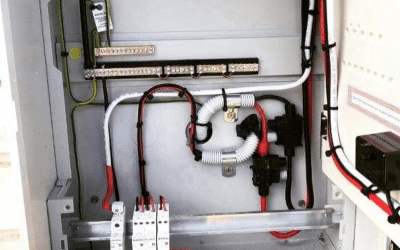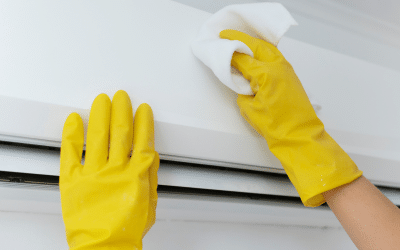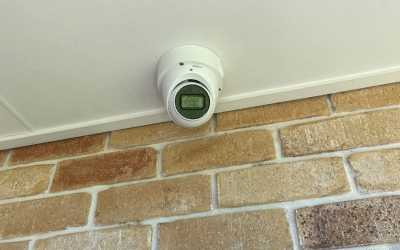With energy bills climbing rapidly, households all over Australia are looking for ways to reduce their power consumption. As one of the most costly appliances to run, it’s little surprise that one of the first things most people look to save electricity is their air conditioning system.
However, in the Australian summer, AC isn’t a luxury – it’s a necessity. And try as they might, most people fail to reduce their AC usage because it’s essential to their comfort during the long, sweltering summer.
Fortunately, you don’t have to compromise on your comfort if you learn how to use your air conditioning system more efficiently. With a few simple but highly effective tips and tricks, you can prevent your AC units from having to work as hard as before while saving on your energy bill and extending the lifespan of your AC system.
With all this in mind, let’s look at different ways to save on your air conditioning energy bill during the hot summer months.
What’s The Ideal AC Temperature During Summer?
A crucial thing to keep in mind if you’re looking to save on your AC energy bill this summer is the lower you set the temperature, the harder your AC system has to work, the more energy it will consume, and the higher your will be. In fact, for every degree you lower your AC temperature, you increase its power consumption by around 10%. Consequently, you’ll lower your energy bills if you get into the habit of setting the temperature a little higher than you usually do.
Generally speaking, the optimal AC temperature during summer is 23 – 24℃. However, 25 – 27 °C is the best temperature for saving money on your electricity bills. Naturally, with Australia being as vast as it is, this varies slightly depending on the state or territory. The table below shows the ideal temperature per region.
|
Region |
Ideal AC Temperature |
|
Nth QLD, Nth WA, NT, And Central Australia |
21 – 23 °C |
|
Sth QLD AND Nth NSW |
25 °C |
|
SA |
24 – 25 °C |
|
TAS |
28 °C |
|
Sth WA |
23 – 24 °C |
|
Sth NSW, Nth VIC, And ACT |
26 – 27 °C |
|
Sth VIC |
24 °C |
How Much Does It Cost to Run an AC System?
The annual cost of running your AC system is dependent on several factors, which include:
- The electricity price
- Frequency of use
- The temperature the system runs at
- The size of your AC system
- The AC system’s efficiency rating
- The size and design of your home
- How well the AC system suits the size and layout of your home
- The age of the system
- How well it was installed
- How often it’s maintained
With such a large and varied array of factors, it’s little surprise that an AC system’s running costs vary considerably from household to household. Now, that said, the average yearly costs of running an AC system are:
- Small AC Systems (up to 4kW): $310 – $490
- Medium AC Systems (4–6kW): $390 – $550
- Large AC Systems (over 6kW): $420 – $600
For more accurate estimates of the cost of running your AC system, you can use Ergon Energy’s air conditioning calculator. It allows you to calculate your power bill based on current energy prices, the system’s size, the set temperature, and the frequency of use.
7 Essential Tips For Saving on Your AC Energy Bills This Summer
Now that you know more about how much your AC costs to run and the ideal temperatures to set it to, let’s look at the seven best ways to cut your air conditioning electricity bill this summer.
Please note – or any advice that requires you to handle your AC units in any way, make sure that system is turned off before attempting any troubleshooting.
Let’s move on to the problem of your AC system blowing hot or warm air and what you can do about it.

Keep Your AC Well Maintained
The less frequently your AC system is maintained, the longer the period in which dirt, dust, and damage can accumulate. This forces your AC to work harder: consuming more energy than it should and increasing your energy bills. Worse still, an AC system that doesn’t receive regular maintenance will wear out its components faster, which makes it less efficient and shortens its lifespan.
Common AC problems caused by a lack of maintenance include dirty air filters, blocked or damaged ducts, and clogged-up outer units. These issues compromise airflow, which your AC system must compensate for by expending more energy to push air out. Unfortunately, these problems can worsen if left unchecked and cause additional, more severe issues like water or refrigerant leaks and electrical damage. Fortunately, however, you can often solve such problems yourself by referring to your AC system’s manufacturer’s instructions before opening up and cleaning your AC units as advised.
Now, while you can carry out some AC maintenance yourself, other, more involved work has to be done by a professional AC repair service. The cost of professional maintenance not only saves on your energy bills but avoids wearing, or blowing, out vital internal components that would result in expensive repairs – or having to replace your AC system altogether! Another invaluable bonus of regular air conditioning maintenance is improved indoor air quality, which helps to improve the health and well-being of you and your loved ones.
Set Your Thermostat to Money-Saving Temperatures
Setting your thermostat to a comfortable temperature that doesn’t cause your AC system to work too hard is an effective money-saving measure. As a general rule of thumb, program your thermostat so that the temperature inside your home is no less than 8°C below the outdoor temperature.
Better still, use your thermostat’s built-in timer to set the hours that your AC system runs, so you or members of your house don’t leave it on absent-mindedly and needlessly add to your power bill. On a similar note, you can use your AC’s economical setting if it happens to have one.
Stay in the Shade And Use Passive Cooling Techniques
Using shading and other passive cooling techniques reduces your home’s indoor temperature, which helps lower your energy bill. By being creative about keeping warm UV rays and hot air from entering your house, your AC system doesn’t have to be on as often or work as hard when running.
This includes:
- Closing blinds, curtains, and shutters on especially hot days.
- For rooms that directly face the sun and tend to get warmer, fitting curtains or blinds with light-coloured backings are a great additional cooling measure, as they help deflect heat. Similarly, tinted windows can decrease heat absorption in sun-facing rooms considerably.
- Installing exterior window shades or awnings.
Planting trees, hedges, shrubs, and vines around your home. Plants provide additional shade and reduce the surrounding temperature through evapotranspiration (a fancy way of saying they remove warm moisture from the air).
Optimise Air Circulation And Use Fans As Much As Possible
While on the subject of passive cooling techniques, you can’t overlook the importance of proper ventilation and its role in running your air conditioning system efficiently. Good ventilation results in better air circulation because it helps to push out the warm air driving up the indoor temperature while better distributing the cool air produced by the AC.
The first way to improve air circulation is to ensure your AC units aren’t being obstructed in any way. As mentioned above, when stating the importance of regular AC maintenance, restricted air flow typically forces your AC to work harder than it should. This results in higher power consumption and can damage the system’s internal components, which can incur considerable unwanted costs to repair or replace.
To rectify this, check the indoor AC units aren’t blocked by furniture, light fittings, curtains, etc. It would also help if you opened them to check for clogged filters or a build-up of dust and grime. Then, check the outdoor unit isn’t obstructed by any hedges, shrubs or other plants. You should also remove the unit’s panel and check for dirt, grime, and lawn clippings that could have found their way inside – and built up around the unit’s fan blades. If the airflow is still weak after this, it’s wise to call an AC maintenance service to check the ductwork and individual units for blockage or damage.
A second way of improving air circulation is to use fans to distribute cool air throughout your home. Ceiling fans are effective for circulating cool air, while pedestal and desk fans positioned close to open windows are handy for removing warm air. Alternatively, you can use these fans in place of your AC system when there are one or two people home or when it’s not scorching hot outside – like in the evenings when the temperature drops.
Turn Off Unused Heat-Emitting Devices And Lights
Household appliances and electronic devices, such as computers, TVs, washing machines and dryers, ovens, and fridges, emit heat. Though not to the same extent, the same is true for the lighting within your home. It’s then up to your AC system to dissipate the heat produced by these items to lower the indoor temperature.
Making sure you switch off heat-emitting objects and lights when they’re not being used is an underrated yet simple way to shave dollars from your AC bill. Plus, turning off lights and appliances (which includes unplugging them) when they’re not in use also saves you money on your electricity bill!
Turn Off Your AC At Night or Use its Timer to Limit its Use
Take advantage of the cooler evening air and switch off your AC to save on your energy bill. If the outdoor temperature is cool enough, or better still, there’s a gentle breeze going, open the windows on both sides of your home to bring the indoor temperature and enhance airflow.
Alternatively, if you or a member of your household needs to have the AC on as they fall asleep, you can time your system to switch off shortly after you’ve gone to bed.
Consider Replacing Your AC System
If the energy-saving tips shared above don’t bring down your energy bills, you should consider replacing your air conditioning system. You might also think about replacing your AC system if you’ve had it for 10 – 15 years or it was already installed when you moved in and you don’t find it that effective.
Now, while you’ll have the high initial cost of a new AC system, you’ll cut down your energy bills in the long term – and the upgrade will eventually pay for itself! For starters, newer models are more energy efficient than their predecessors and must comply with Minimum Energy Performance Standards (MEPS).
Improve Your Home’s Insulation
Ensuring your home is adequately insulated prevents excessive amounts of cool air from escaping and helps you get more from your AC system at a lower cost. Improving the insulation in the attic stops it from reaching furnace-like temperatures as the sun beams down on your roof –and the resulting trapped heat from spreading throughout your house. Additionally, sealing the gaps around windows and doors, with caulk or weatherstripping, for instance, traps the cool air blown through by the AC.
Let’s summarise this:
- The lower you set the temperature, the harder your AC system has to work, the more energy it will consume, and the higher your will be. Subsequently, in general, the optimal AC temperature during summer is 23 – 24℃. However, 25 – 27 °C is the best temperature for saving money on your electricity bills.
- Theaverage annual costs of running an AC system are:
- Small AC Systems (up to 4kW): $310 – $490
- Medium AC Systems (4–6kW): $390 – $550
- Large AC Systems (over 6kW): $420 – $600
- 7 excellent ways to save on your air conditioning electricity bills during summer
- Keep your AC well maintained
- Set your thermostat to money-saving temperatures
- Stay in the shade and use passive cooling techniques
- Optimise air circulation and use fans as much as possible
- Turn off unused heat-emitting devices and lights
- Turn off your AC at night or use its timer to limit its use
- Consider replacing your AC system
To discuss any of the money-saving tips in this post or to schedule an AC maintenance appointment, contact LeoLec Services. We’ve helped households all over Brisbane and along the Sunshine Coast to save money on their air conditioning energy bill when the temperature starts to soar– and we’re confident we can help you shave dollars off your future power bills too.







